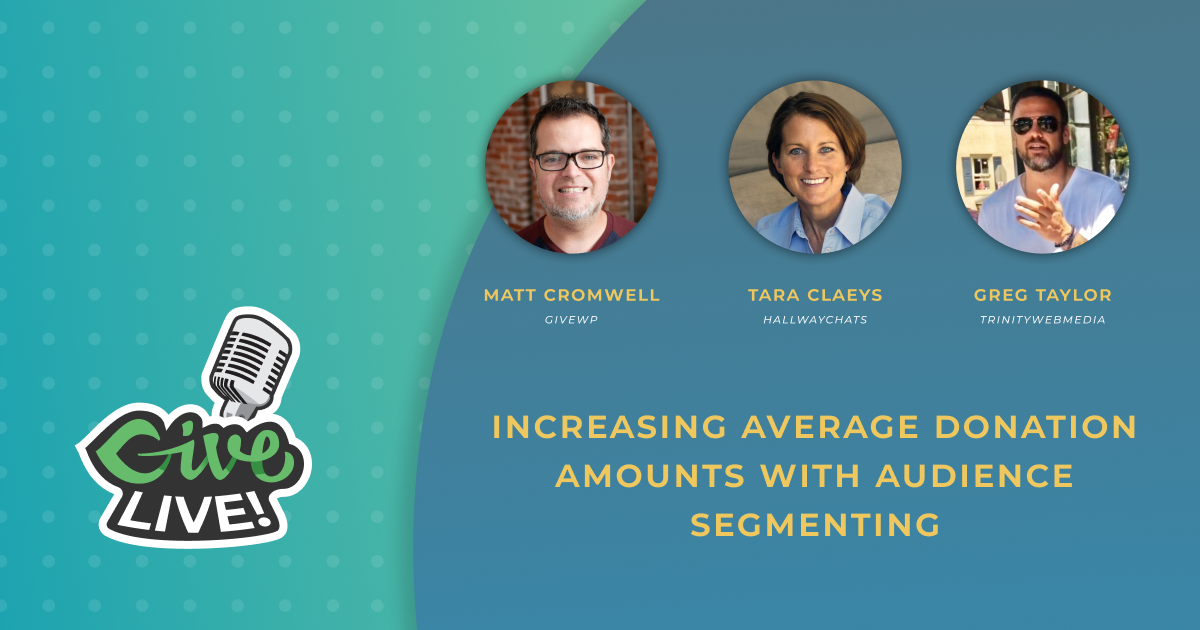When we asked the average donation size for nonprofits, we were pleasantly surprised when Trinity Web Media told us that their nonprofit client averages $415 per donation. That’s an extremely high donation average for most nonprofits.
So we asked, how did you do it? Here’s what they said:
Mostly, it has to do with how @TrinityWebMedia creates donor personas based on interests and historical donor date then creates appropriate donor landing pages.
— Greg Taylor (@GRTaylor2) September 14, 2020
You might be saying, “Donor personas? How does that increase your average donation amount overall?”
We investigated for you on Give LIVE, with our guest, Greg Taylor from Trinity Web Media, and co-host Tara Claeys, owner of Design TLC.
Where does the data to create donor personas come from?
To create donor personas, you need access to historical donor data. If you don’t have any, you will need to make sure that you set up a way to collect this information moving forward.
Donor data comes from things like GiveWP’s built-in fundraising reports, an email marketing platform, or a CRM.
“You can’t just look at the Give data, and the MailChimp data, and the google analytics data. You have to look at all of it together.”
– Tara Claeys
Trinity Web media had access to Donor Perfect, GiveWP, and Mailchimp data for their nonprofit client. They used this information to create personas and ultimately increase average donation amounts as a whole.
Many nonprofit-oriented marketing agencies have a difficult time getting access to this data or don’t have a large enough team to take on this task for clients. Tara’s is one that traditionally doesn’t see donor data on this level. In these cases, marketing agencies like Tara’s align their clients to do this work by setting up the right tools.
How do you create personas from donor data?
Once you have all of this data in one system, then you can parse it into actionable insights. Most marketers use spreadsheets, but we recently met with another GiveWP user who uses Airtable to do exactly what Greg talks about in this Give LIVE.
“In order to do this, we don’t all have to be data scientists… all you have to do is be able to sit back, look at the data, and say ‘Okay, I see where this is going.’”
– Greg Taylor
The main data point that Trinity Web Media uses to determine donor personas are donation amounts and frequencies. Other data you might want to use includes:
- Personal or corporate donor?
- One-time or recurring?
- Where did the donor come from? (You can find this data using Google Analytics UTMs alongside forms using the GiveWP Google Analytics add-on. We discuss how you can see this data in our advice about using Airtable.)
To decide on which data to use and how to create personas, Greg Taylor uses a process from Susan Baier, founder of Audience Audit. His main piece of advice is to not confuse donor personas with general demographic information. How old someone is may not be as important as their preferred method of giving. Identify your personas based on behaviors and attitudes.
Here are some example donor segments Greg mentions:
- Large personal donors
- Recurring givers
- Small one-time donors
- Corporate donors
- Board members who give
- People who were impacted by the organization then returned to give later on
Not all of these segments will fit your organization. Let the data guide your segmentation.
Like What You're Reading? Subscribe Here!
Newsletter Opt-in
What’s the best way to market to each segment?
After you start figuring out what the storyline is and where the donations lie on that, you will have more success marketing your fundraising campaigns toward specific segments.
“What’s important to your org? What moves the needle? What nurtures the donor along and avoids donor fatigue?”
– Greg
When we talk about segmentation and audiences, most people think of email marketing systems as well as ads targeting. But, you need to go beyond that in order to really harness the power of your donor personas.
Trinity Web Media creates a specific donation landing page for each donor persona. That way, they know they’re talking to each person directly in the way that best resonates with them.
However, Tara brought up a great looming question,
“How do you cut through the noise? Especially in an election year, with the pandemic going on?”
She has found herself bombarded with marketing emails, as we all have, more so now than ever before.
Greg believes there isn’t one tried and true method, but a lot of testing and repeating. If you’re able to tell a story that speaks to your personas, knowing why your organization is important to those people, then you will inherently rise above the noise and avoid donor fatigue.
On the other hand, this isn’t always the case. This is when Greg insists that thinking outside the box is crucial. Try sending a personal donation ask from the president of the organization, or someone who was impacted by its mission. You can also try sending out an update with true transparency. Give your donors a glimpse behind the scenes at your organization.
“We do dedications, too. A lot of times, the person wants to personalize their donations. When other people start telling their story with your organization, that’s super powerful within the donor community.”
– Greg
There is no single best way to market to any particular segment. The best thing to do is test your campaigns, analyze the data, make adjustments, and repeat.
What technology works best to segment fundraising based on donor data?
The biggest hurdle to overcome in using donor personas is setting up the technology to gather and analyze the data as well as optimize your donor experience.
“Give and WordPress are a huge part of our problem solving toolbox… Give makes the donation mechanism seamless. It’s my job to get it there.”
– Greg
Greg recommends taking these steps before you launch your next fundraiser:
- Make sure you have a solid WordPress site that’s responsive.
- Clarify your story and make it prominent on your donation landing pages.
- Export all data from any CRM tools you have, including GiveWP.
- Import this data into a spreadsheet (or Airtable) to manipulate it so you can see trends and decide on donor persona segments.
- Import this data into your chosen email marketing tool using your different segments.
- Create landing pages for each persona throughout your campaign by understanding which messaging and images resonate with audiences best.
- Use A/B testing to review, refine, and repeat the process.
How do you set the right suggested donation amounts for each persona?
To set suggested donation amounts on your various landing pages, you can use GiveWP to set different levels on each form. There are a variety of ways you can choose to set this up.
Greg recommends startings with the average donation of that persona. Include that in one of the donation levels, but make sure that there are higher options available. Then, ask the donor for a slightly higher donation than they gave previously. You should also have an “other” option for people to enter their own amounts.
“I think it’s a huge misstep for a lot of online fundraising when you send everyone the same donation form. If you send everyone the same donation form with suggested amounts, let’s just say $75, $100, $250 but you don’t know that person gave $5,000 last year, why would you want to make it harder for that person to give a larger amount? When you can identify your persona and a segment through donation history, you can say, ‘okay this person should get this landing page with these suggested amounts.’ And we always give the option for a recurring donation, because if we can get $100 12x a year vs $250 one time, that is a huge win”
– Greg
Won’t higher donation averages result in higher credit card processing fees?
One major concern for most online fundraisers is credit card fees. That’s where the GiveWP Fee Recovery add-on can help.
“We don’t do it without that”
– Tara
Greg agrees and says that they usually see about 45% of donors opt-on to cover their donation credit card processing fees. And, the donors that typically choose to cover the fees are the ones who give higher amounts.
What about donor privacy and data collection laws?
The last and final concerns for most when discussing donor data are privacy and compliance. When it comes to collecting and using your donor data, make sure that you’re transparent with your donors.
The terms and conditions on GiveWP forms can be customized to reflect this if you want to be more clear with your donors about how their donor data is used.
How will you use donor personas?
We hope you found this Give LIVE as useful as we did. Greg and Tara shared tons of useful insights about how best to market your fundraisers to your donors.
If you’d like help setting up your WordPress website so that you can collect this information with GiveWP, our Customer Success team is happy to help. Schedule a demo, today.


